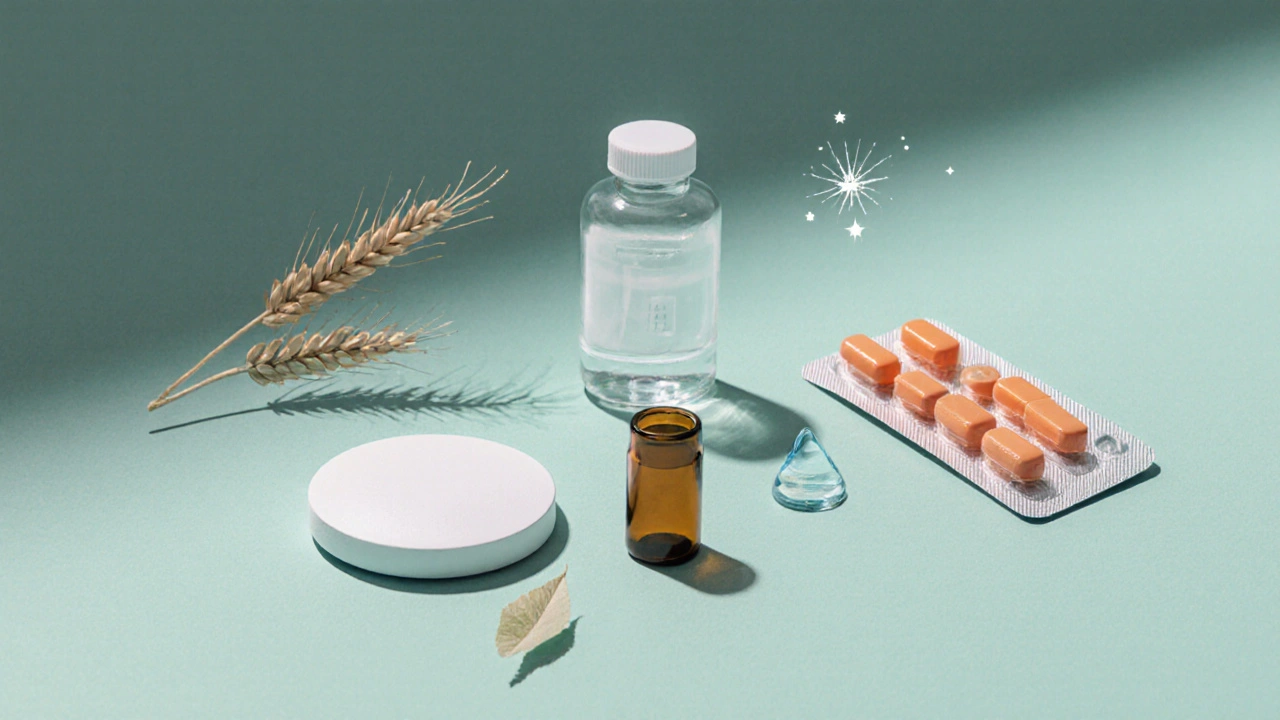Cycrin vs Alternatives Comparison Tool
Quick Comparison Summary
Cycrin (Medroxyprogesterone)
- Synthetic progestin
- Used for HRT, endometrial hyperplasia, cancers
- Oral tablets, 2.5-10 mg daily
- Low-moderate clot risk
- £0.10-£0.20 per tablet (generic)
Main Alternatives
- Provera: Same synthetic progestin
- Depo-Provera: Injectable, 12-14 weeks
- Norethisterone: Higher androgenicity
- Micronised Progesterone: Bio-identical, lower mood effects
- Natural Cream: Topical, not systemic
Detailed Attribute Comparison
| Attribute | Cycrin | Provera | Depo-Provera | Norethisterone | Micronised Progesterone |
|---|---|---|---|---|---|
| Drug Class | Synthetic progestin | Synthetic progestin | Synthetic progestin (injectable) | Synthetic progestin (higher androgenicity) | Bio-identical progesterone |
| Typical Oral Dose | 2.5-10 mg daily | 2.5-10 mg daily | 150 mg IM every 12-14 weeks | 5-10 mg daily | 100-200 mg daily (or 200-400 mg vaginally) |
| Primary Uses | HRT, endometrial hyperplasia, certain cancers | Same as Cycrin | Contraception, HRT adjunct | Menstrual disorders, endometriosis | HRT, luteal-phase support |
| Common Side Effects | Weight gain, headache, breast tenderness | Similar to Cycrin | Irregular bleeding, weight gain | Acne, hirsutism, mood changes | Sleepiness, mild GI upset |
| Risk of Blood Clots | Low-moderate | Low-moderate | Low-moderate | Similar to other synthetic progestins | Very low |
| Cost (UK, 2025) | £0.10-£0.20 per tablet (generic) | £0.12-£0.22 per tablet | £30-£45 per injection | £0.25-£0.35 per tablet | £0.80-£1.20 per capsule |
| Prescription Requirement | Yes | Yes | Yes (administered by clinician) | Yes | Yes (often via pharmacy) |
Decision Guide for Choosing Progestins
Consider These Factors
- Primary Goal: Contraception? Menopause relief?
- Liver/Clotting Concerns: Synthetic vs bio-identical?
- Injection Comfort: Oral vs injectable route?
- Cost: Generic vs specialty medications?
- Side Effect Tolerance: Mood swings? Weight gain?
Quick Tips
- Generic Cycrin/Provera = lowest cost
- Micronised progesterone = fewer mood-related side effects
- Depo-Provera = long-term contraception
- Norethisterone = for menstrual/endometriosis issues
- Always consult your doctor before switching
Important Note: This tool provides general information. Always consult with your healthcare provider for personalized medical advice and to determine the best progestin option for your specific needs.
Safety Considerations
General Warnings: Avoid in women with active breast cancer, uncontrolled hypertension, or thromboembolic disease.
- Cycrin/Provera: May worsen migraines with aura
- Depo-Provera: Bone density loss over time
- Norethisterone: Can worsen PCOS symptoms
- Micronised Progesterone: Safe in liver disease but adjust dose
Monitoring: Routine labs every 6-12 months to detect emerging issues early.
When you or your doctor are deciding on a progestin for hormone therapy or contraception, the market can feel like a maze. Cycrin is one option, but there are several others that might fit better depending on your health goals, budget, and lifestyle. This guide breaks down what Cycrin is, who uses it, and how it stacks up against the most common alternatives.
Key Takeaways
- Cycrin (medroxyprogesterone acetate) is a synthetic progestin used for hormone replacement therapy (HRT), menstrual disorders, and certain cancers.
- Primary alternatives include oral Provera, injectable Depo‑Provera, norethisterone, micronised progesterone, and natural progesterone creams.
- Effectiveness is similar for most indications, but side‑effect profiles and dosing convenience differ noticeably.
- Cost varies widely: generic medroxyprogesterone is cheap, while micronised progesterone can be several times more expensive.
- Choosing the right agent should involve a discussion about your specific condition, liver function, clotting risk, and personal preference for oral versus injectable routes.
Below you’ll find a step‑by‑step look at each option, a side‑by‑side comparison table, and practical tips for talking with your healthcare provider.
What Is Cycrin?
Cycrin is a brand name for medroxyprogesterone acetate, a synthetic progestin that mimics the activity of natural progesterone. It was first introduced in the 1960s and is approved for a range of uses, including hormone replacement therapy (HRT) in post‑menopausal women, treatment of endometrial hyperplasia, and as part of combination therapy for certain breast‑cancer protocols. The medication is usually taken orally in doses ranging from 2.5mg to 10mg per day, depending on the indication.
Cycrin works by binding to progesterone receptors, reducing uterine lining growth, and providing the “progesterone” component needed to balance estrogen‑driven effects. Because it is fully synthetic, it tends to have a slightly higher affinity for the receptor than natural progesterone, which translates to a predictable pharmacokinetic profile but also a distinct side‑effect spectrum.
Common Alternatives to Cycrin
When clinicians consider a progestin, they typically evaluate a handful of well‑studied alternatives. Below are the most frequently prescribed options, each introduced with microdata for easy reference.
Provera (medroxyprogesterone acetate oral tablets) is essentially the same molecule as Cycrin, marketed under a different name in many countries. Dosing and indications overlap almost exactly, making it a direct generic counterpart.
Depo‑Provera is an injectable form of medroxyprogesterone acetate given every 12 to 14weeks. It is popular for long‑acting contraception and for women who struggle with daily pill adherence.
Norethisterone (also sold as Megace) is a different synthetic progestin with a slightly higher androgenic activity. It is often used for menstrual‑related disorders and for endometriosis symptom control.
Micronised Progesterone (brand names like Utrogestan) is a bio‑identical form of natural progesterone, derived from plant sterols. It is taken orally or vaginally and is prized for its lower risk of mood‑related side effects.
Natural Progesterone Cream is a topical preparation that delivers progesterone transdermally. While not approved for systemic hormone therapy in many regions, some patients use it for mild menopausal symptoms.
Side‑by‑Side Comparison
| Attribute | Cycrin (Medroxyprogesterone) | Provera (Oral) | Depo‑Provera (Injectable) | Norethisterone | Micronised Progesterone |
|---|---|---|---|---|---|
| Drug class | Synthetic progestin | Synthetic progestin | Synthetic progestin (injectable) | Synthetic progestin (higher androgenicity) | Bio‑identical progesterone |
| Typical oral dose | 2.5‑10mg daily | 2.5‑10mg daily | 150mg IM every 12‑14weeks | 5‑10mg daily | 100‑200mg daily (or 200‑400mg vaginally) |
| Primary uses | HRT, endometrial hyperplasia, certain cancers | Same as Cycrin | Contraception, HRT adjunct | Menstrual disorders, endometriosis | HRT, luteal‑phase support |
| Common side effects | Weight gain, headache, breast tenderness | Similar to Cycrin | Irregular bleeding, weight gain | Acne, hirsutism, mood changes | Sleepiness, mild GI upset |
| Risk of blood clots | Low‑moderate | Low‑moderate | Low‑moderate | Similar to other synthetic progestins | Very low |
| Cost (UK, 2025) | £0.10‑£0.20 per tablet (generic) | £0.12‑£0.22 per tablet | £30‑£45 per injection | £0.25‑£0.35 per tablet | £0.80‑£1.20 per capsule |
| Prescription requirement | Yes | Yes | Yes (administered by clinician) | Yes | Yes (often via pharmacy) |

How to Choose the Right Progestin for You
Picking a progestin isn’t just about price-it’s about matching the drug’s pharmacology with your personal health profile. Here’s a quick decision‑tree you can run through with your doctor:
- What is the primary goal? If you need reliable contraception, Depo‑Provera’s 3‑month dosing may win. For menopausal symptom relief, micronised progesterone offers a softer side‑effect profile.
- Do you have liver or clotting concerns? Synthetic progestins like Cycrin and Norethisterone are processed by the liver and carry a modest clot risk. Bio‑identical progesterone (micronised) has a lower hepatic load.
- How comfortable are you with injections? If needles are a turn‑off, stick with oral options. If you want fewer pills, the injectable route is attractive despite the need for clinic visits.
- Is cost a barrier? Generic Cycrin/Provera is the cheapest, while micronised progesterone can be three‑to‑four times more expensive.
- What side effects are most concerning? Mood swings and weight gain are common with synthetic progestins. If these are a deal‑breaker, consider the bio‑identical alternative.
After answering these questions, you and your clinician can weigh the trade‑offs shown in the table above and settle on a regimen that feels manageable.
Safety, Contra‑indications, and Monitoring
All progestins share a core set of warnings: they should be avoided in women with active breast cancer, uncontrolled hypertension, or a history of thromboembolic disease. Specific nuances include:
- Cycrin/Provera: May exacerbate migraine with aura and can elevate triglycerides slightly.
- Depo‑Provera: Prolonged use can lead to decreased bone mineral density; periodic DEXA scans are advised.
- Norethisterone: Higher androgenicity can worsen polycystic ovary syndrome (PCOS) symptoms.
- Micronised Progesterone: Generally safe in liver disease, but dosage should be reduced in severe hepatic impairment.
Routine labs (CBC, liver function tests, lipid profile) every 6-12months help catch any emerging issues early.
Cost, Availability, and Insurance Coverage (UK, 2025)
In the UK, Cycrin and its generic equivalents are listed on the NHS formulary, meaning most patients obtain them at minimal cost if prescribed. Depo‑Provera injections are also NHS‑covered but require a clinic visit, which can add hidden transport costs.
Micronised progesterone, marketed as a “bio‑identical” option, is often classified as a “specials” medication and may require a separate prescription charge unless specifically approved for HRT under the NHS. Private pharmacies typically price it higher, and some insurance plans treat it as a non‑essential supplement.
When budgeting, remember to factor in the frequency of doctor visits (injectables) and any lab monitoring required for long‑term therapy.
Real‑World Patient Stories (Illustrative)
Emma, a 52‑year‑old from Bristol, switched from Cycrin to micronised progesterone after experiencing persistent weight gain and mood swings. Within three months, her weight plateaued and she reported improved sleep. Her GP kept an eye on liver enzymes, which remained stable.
James, a 28‑year‑old teacher, chose Depo‑Provera for contraception after missing several oral pills. He appreciates the quarterly schedule, but his GP schedules an annual bone density scan to counteract the known risk of bone loss.
These anecdotes highlight that the “best” choice is highly individual.
Next Steps for Readers
1. List your primary health goal (e.g., menopause relief, contraception, endometrial protection).
2. Note any personal risk factors (history of clotting, liver disease, mood concerns).
3. Bring the comparison table to your next appointment and discuss the trade‑offs that matter most to you.
4. Ask your clinician about monitoring plans and whether a generic prescription or a bio‑identical option fits your budget.
5. Keep a symptom diary for the first 8-12weeks after starting any new progestin; this data helps fine‑tune the regimen.

Frequently Asked Questions
Is Cycrin the same as Provera?
Yes. Both contain medroxyprogesterone acetate and are used for the same indications. The main difference is branding and, in some regions, pricing.
Can I switch from Cycrin to micronised progesterone?
Switching is possible but should be done under medical supervision. Dosage conversion isn’t one‑to‑one, and your doctor will monitor hormone levels and side effects during the transition.
What are the biggest side effects of Depo‑Provera?
Irregular bleeding, weight gain, and a gradual decrease in bone mineral density are the most commonly reported issues. Regular bone health checks are recommended for long‑term users.
Is there a risk of blood clots with Cycrin?
Cycrin carries a low‑to‑moderate risk, similar to other combined hormone therapies. Women with a personal or family history of thromboembolic disease should discuss alternative options with their clinician.
How much does micronised progesterone cost on the NHS?
Unlike generic medroxyprogesterone, micronised progesterone is usually classified as a “specials” prescription and may incur a standard NHS prescription charge unless it’s approved for a specific condition under the formulary.

First, let me lay out the pharmacological landscape in exhaustive detail, because understanding the nuances of Cycrin (medroxyprogesterone acetate) is essential for any informed decision; the drug belongs to the synthetic progestin class, it binds with high affinity to progesterone receptors, and it modulates the endometrium in a predictable manner, which is why it is prescribed for hormone replacement therapy, endometrial hyperplasia, and certain oncology protocols, among others. The oral bioavailability of medroxyprogesterone is relatively high, allowing for daily dosing ranging from 2.5 mg to 10 mg, and the half‑life supports steady‑state concentrations without the need for frequent titration; this is a major advantage over some non‑oral formulations that require depot injections. Cost is a critical factor, especially in the UK market where generic tablets can be purchased for as little as £0.10 per pill, a price point that dramatically lowers the barrier to adherence for patients who might otherwise struggle with expense. Compared to alternatives such as Provera, which is essentially the same molecule under a different brand, there is no clinically meaningful difference in efficacy or safety, although pricing variations may exist due to branding and supply chain considerations. When you contrast Cycrin with Depo‑Provera, the injectable form, you must account for the pharmacokinetic profile: the depot injection delivers a massive dose (150 mg) every 12–14 weeks, which can be convenient for contraception but also carries a distinct side‑effect spectrum, including potential bone mineral density loss that necessitates periodic DEXA scans. Norethisterone, by contrast, exhibits higher androgenic activity, leading to side effects such as acne and hirsutism, which may be undesirable for women sensitive to hormonal fluctuations; this underscores the importance of matching the drug’s receptor profile to the patient’s hormonal milieu. Micronised progesterone, a bio‑identical preparation, is metabolized differently, often causing fewer mood‑related side effects, yet it is considerably more expensive, ranging from £0.80 to £1.20 per capsule, which can be prohibitive for long‑term therapy. Lastly, the clotting risk associated with synthetic progestins, including Cycrin, remains low‑to‑moderate, but clinicians should still screen for personal or familial thromboembolic history before initiating therapy; this precautionary step is standard across all hormonal agents. In summary, the choice between Cycrin and its alternatives hinges on a triad of factors: cost, route of administration, and side‑effect profile, all of which must be evaluated in the context of the patient’s individual health goals and risk factors.
What a thorough overview! It really helps to see how each option fits into a bigger picture of wellness and personal choice. The optimism around having affordable generic choices like Cycrin is uplifting, and it reminds us that health decisions can be both practical and empowering. When we reflect on the broader impact of hormone therapy, we see a beautiful interplay between biology and personal agency, encouraging a hopeful outlook for anyone navigating these choices.
Thinking about the decision tree, it’s clear that aligning your health goals with the drug’s properties can be a powerful motivator. If you value convenience, an injectable like Depo‑Provera offers a quarterly rhythm; if you prioritize mood stability, micronised progesterone might be the gentle path. Keep in mind your liver health and clotting risk as you weigh these options, and let that thoughtful analysis drive a confident choice.
Cost matters a lot.
Hey there, just wanted to say you’ve got this! Think of the comparison as a coach guiding you through a workout – start with the baseline (Cycrin), then add variations (alternatives) based on what feels right for your body and wallet. Remember, consistency beats perfection, so pick the regimen you can stick with and celebrate each small win along the way.
It’s morally concerning that many patients are pushed toward synthetic hormones without fully understanding the long‑term implications. The simplicity of the language in many drug leaflets masks a deeper ethical issue: informed consent is compromised when cost pressures outweigh transparent risk communication.
Wow this post is like a rollercoaster of facts and drama, I mean the cost breakdown is sooo mind‑blowing, and the side effect list reads like a horror script-seriously, who can keep track of all this? It’s a lot, but hey, at least we got the tables and everything, lol.
There’s a lot of useful data here, especially the side‑effect profiles and dosing schedules. It’s helpful to see the clear breakdown so readers can match the medication to their specific needs without having to hunt through multiple sources.